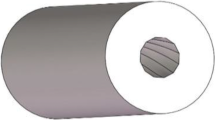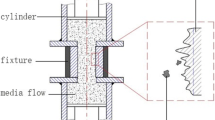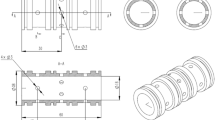Abstract
Abrasive flow polishing technology (AFPT) is a novel method of precision machining for improving the surface precision of the workpiece, where the micro-cutting process can be achieved for the finishing process of the inner surface of the workpiece through its contact with an abrasive. In order to investigate the vortex formation mechanism of the baffle servo valve nozzle of abrasive flow precision polishing (AFPP), the large eddy simulation (LES) method has been employed to analyze the flow path of abrasive flow and the effect of the vortex on the nozzle wall surface. To clarify the precise polishing action of abrasive flow, the impact of cutting behavior of abrasive particles is carried out with the vortex of the nozzle wall surface. The quality control method of abrasive flow precision polishing (AFPP) baffles servo valve nozzle is revealed from the formation mechanism of different cross-section vortices. It is concluded that the grinding speed of the abrasive flow has an important influence on the polishing quality of the abrasive flow. The higher the grinding speed, the better the precision of the abrasive flow. Finally, our results led us to conclude that the abrasive flow precision polishing technology (AFPPT) can effectively improve the surface quality of the nozzle orifice. Moreover, it can improve the abrasive flow grinding speed which can effectively improve the surface accuracy of the workpiece for the ideal surface quality.




















Similar content being viewed by others
References
Petare AC, Jain NK (2018) On simultaneous improvement of wear characteristics, surface finish and microgeometry of straight bevel gears by abrasive flow finishing process. Wear 404-405:38–49. https://doi.org/10.1016/j.wear.2018.03.002
Sankar MR, Jain VK, Ramkumar J, Sareen SK, Singh S (2018) Medium rheological characterization and performance study during rotational abrasive flow finishing (R-AFF) of Al alloy and Al alloy/SiC MMCs. Int J Adv Manuf Technol 100(5-8):1149–1163. https://doi.org/10.1007/s00170-018-2244-y
Zhang L, Yuan Z, Qi Z, Cai D, Cheng Z, Qi H (2018) CFD-based study of the abrasive flow characteristics within constrained flow passage in polishing of complex titanium alloy surfaces. Powder Technol 333:209–218. https://doi.org/10.1016/j.powtec.2018.04.046
Petare AC, Jain NK (2018) A critical review of past research and advances in abrasive flow finishing process. Int J Adv Manuf Technol 97(1-4):1–42. https://doi.org/10.1007/s00170-018-1928-7
Wang TT, Chen D, Zhang WH, An LL (2019) Study on key parameters of a new abrasive flow machining (AFM) process for surface finishing. Int J Adv Manuf Technol 101(1-4):39–54. https://doi.org/10.1007/s00170-018-2914-9
Chen F, Hao S, Miao X, Yin S, Huang S (2018) Numerical and experimental study on low-pressure abrasive flow polishing of rectangular microgroove. Powder Technol 327:215–222. https://doi.org/10.1016/j.powtec.2017.12.062
Singh S, Kumar D, Sankar MR, Jain VK (2018) Viscoelastic medium modeling and surface roughness simulation of microholes finished by abrasive flow finishing process. Int J Adv Manuf Technol 100(5–8):1165–1182. https://doi.org/10.1007/s00170-018-1912-2
Kenda J, Duhovnik J, Tavčar J, Kopač J (2014) Abrasive flow machining applied to plastic gear matrix polishing. Int J Adv Manuf Technol 71(1-4):141–151. https://doi.org/10.1007/s00170-013-5461-4
Li J, Ji S, Tan D (2017) Improved soft abrasive flow finishing method based on turbulent kinetic energy enhancing. Chin J Mech Eng 30(2):301–309. https://doi.org/10.1007/s10033-017-0071-y
Li JY, Meng WQ, Dong K, Zhang XM, Zhao WH (2018) Study of effect of impacting direction on abrasive nanometric cutting process with molecular dynamics. Nanoscale Res Lett 13(1):1–11. https://doi.org/10.1186/s11671-017-2412-2
Sagaut P (2005) Large eddy simulation for incompressible flows. Springer, Berlin. https://doi.org/10.1007/b137536
Meneveau C, Katz J (2000) Scale-invariance and turbulence models for large-eddy simulation. Annu Rev Fluid Mech 32(1):1–32. https://doi.org/10.1146/annurev.fluid.32.1.1
Chong ST, Hassanaly M, Koo H, Mueller ME, Raman V, Geigle KP (2018) Large eddy simulation of pressure and dilution-jet effects on soot formation in a model aircraft swirl combustor. Combust Flame 192:452–472. https://doi.org/10.1016/j.combustflame.2018.02.021
Laurendeau F, Léon O, Chedevergne F, Senoner JM, Casalis G (2017) Particle image velocimetry experiment analysis using large-eddy simulation: application to plasma actuators. AIAA J 55(318):1–14. https://doi.org/10.2514/1.J055687
Vasaturo R, Kalkman I, Blocken B, Van Wesemael PJV (2018) Large eddy simulation of the neutral atmospheric boundary layer: performance evaluation of three inflow methods for terrains with different roughness. J Wind Eng Ind Aerodyn 173:241–261. https://doi.org/10.1016/j.jweia.2017.11.025
Chen TBY, Yuen ACY, Yeoh GH, Timchenko V, Cheung SCP, Chan QN, Yang W, Lu H (2018) Numerical study of fire spread using the level-set method with large eddy simulation incorporating detailed chemical kinetics gas-phase combustion model. J Comput Sci 24:8–23. https://doi.org/10.1016/j.jocs.2017.10.022
Rezaeiravesh S, Liefvendahl M (2018) Effect of grid resolution on large eddy simulation of wall-bounded turbulence. Phys Fluids 30(5):1–23. https://doi.org/10.1063/1.5025131
Gao M, Huai WX, Xiao YZ, Yang ZH, Ji B (2018) Large eddy simulation of a vertical buoyant jet in a vegetated channel. Int J Heat Fluid Flow 70:114–124. https://doi.org/10.1016/j.ijheatfluidflow.2018.02.003
Bianco V, Khait A, Noskov A, Alekhin V (2016) A comparison of the application of RSM and LES turbulence models in the numerical simulation of thermal and flow patterns in a double-circuit Ranque-Hilsch vortex tube. Appl Therm Eng 106:1244–1256. https://doi.org/10.1016/j.applthermaleng.2016.06.095
Li JY, Wei LL, Zhang XM, Qiao ZM (2017) Impact of abrasive flow polishing temperature on nozzle quality under mesoscopic scale. Acta Armamentarii 38(10):2010–2018. https://doi.org/10.3969/j.issn.1000-1093.2017.10.018
Wu F, Zhang JJ, Ma XX, Zhou WJ (2018) Numerical simulation of gas-solid flow in a novel spouted bed: influence of row number of longitudinal vortex generators. Adv Powder Technol 29(8):1848–1858. https://doi.org/10.1016/j.apt.2018.04.021
Acknowledgments
The authors would like to thank the National Natural Science Foundation of China no. NSFC 51206011, Jilin Province Science and Technology Development Program of Jilin Province no. 20170204064GX, Project of Education Department of Jilin Province no. JJKH20190541KJ, Changchun Science and Technology Program of Changchun City no. 18DY017.
Author information
Authors and Affiliations
Corresponding author
Additional information
Publisher’s note
Springer Nature remains neutral with regard to jurisdictional claims in published maps and institutional affiliations.
Rights and permissions
About this article
Cite this article
Li, J., Zhang, H., Wei, L. et al. Formation mechanism and quality control technology for abrasive flow precision polishing vortex: large eddy simulation. Int J Adv Manuf Technol 105, 2135–2150 (2019). https://doi.org/10.1007/s00170-019-04232-w
Received:
Accepted:
Published:
Issue Date:
DOI: https://doi.org/10.1007/s00170-019-04232-w




